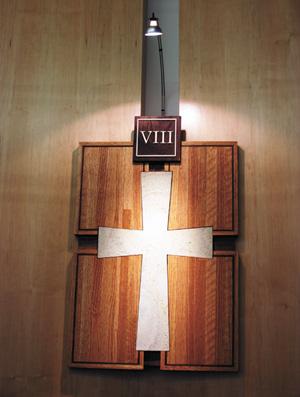
By Kathy Weiss and Celine Klosterman
Motivated by ecology and a tight budget, a group of volunteers at St. Thomas More Parish carefully discerned what from their old church could be reused in the new.
The result is a collection of liturgical furnishings that honor the parish’s heritage and reflect the modern aesthetic of their new worship space in Coralville.
“We are a very ecological parish,” commented Kathy Donnelly, who led an art and environment work group to aid in the transition to the new energy-efficient church.
“We had no budget to work with and out of this came the development of volunteers to complete the work at little or no cost,” says Donnelly, who organized the various projects and sewed a curtain for the reconciliation chapel. “Donations of time, talent and material goods were sought from parish members with a generous response.”
Literally tons of material was reclaimed and reused in the process.
The original Anamosa limestone altar, presider’s chair and ambo were refashioned by local stonemason J.B. Barnhouse and a baptistery was built using leftover stone. Each piece is has a distinctive “broken edge” trim that accentuates the hand-hewn character.
Red oak salvaged from the old church pews was used extensively in the new church and “pew wood” has since been celebrated as an exotic species. Vern Miller crafted a table from it. Dave Johnson made planter boxes, candlesticks and a processional cross. John Lundell used it in 14 Stations of the Cross he handcrafted for the sanctuary.
What remains of the pew wood now, Donnelly said, “can be bought on eBay.”
Additionally, benches and kneelers in the reservation chapel and reconciliation room were refinished and reupholstered, and even the sanctuary light found new life.
“We purchased 100 wood chairs from the church that closed in Parnell,” Donnelly said, citing how they saved money in seating.
“All of the artwork from the old building will be used here,” she says, adding, “We tried to make it as beautiful and spiritual as we could. We are not a very rich parish.”
As they plan for future completion of the lower level of the new church as religious education space, Donnelly said Eagle Scouts have stepped forward to build a meditation garden, a rain garden and a storage shed.
Parishioner Susan Puhl worked with the landscaping contractor to reduce costs and had rain barrels installed to collect non-potable water for reuse. “We’re putting in a natural prairie ourselves,” Donnelly added.
Those who have given time and talent also included Steve Nielsen, Gale Korbet, Mary Kelley, Donna Jondle, Rhonda Staley, Art DeArmond, Paul Bobay, Karen Scudiero, Marti Bradbury, Wendelin Guentner, Carol Manternach, Nancy LePeau and Dave and Carol Johnson.
Design inspired by Thomas More’s residence
Architecturally, St. Thomas More’s new church gives a nod to the past while embracing contemporary design trends.
Designers looked to the 16th-century London residence of Thomas More for inspiration in use of brick, pre-cast concrete and window proportion and dimension, said Paul Jeffrey, senior principal architect with Bahr Vermeer Haecker Architects of Omaha. That firm and Neumann-Monson Architects of Iowa City teamed up to plan St. Thomas More’s building.
The chancel in that building was designed to accommodate the limestone altar and ambo from St. Thomas More’s former church, and wood from the Iowa City church’s pews was used in Stations of the Cross that hang in the Coralville building.
In a more contemporary vein, natural light fills the worship space. Floors are made of exposed concrete, and wood-panel walls add visual warmth and acoustic control, Jeffrey said. In the main worship space, chairs without kneelers are arranged in a fan shape.
Architects also looked toward the church’s future expansion. The current, 500-seat worship space is designed to become a gathering area after a 1,000-seat worship space is added. And the master plan includes space for a social hall with offices, a full kitchen and lower level; a religious education building; and an outdoor area for gathering and worship. Once finished, the church’s lower level will provide for social gatherings and religious education, Jeffrey said.
In a move that reflects modern eco-consciousness, St. Thomas More Church includes energy-saving, environmentally sustainable features such as a geothermal heating system, heavy insulation, bamboo chancel floors and low-energy-use fluorescent lighting strips. Bicycle racks encourage use of environmentally friendly transportation.
The church will apply to receive Leadership in Energy and Environmental Design (LEED) certification, Jeffrey said. That certification system verifies that a building was designed using strategies to improve energy savings, water efficiency, indoor environmental quality and stewardship of resources and reduce carbon dioxide emissions.
St. Thomas More also embraces nature in other ways. Woods to the church’s north and west offer “calming views” and, thanks to the site’s slope, help create a secluded, outdoor gathering area parishioners enter from a walkout lower level, Jeffrey said.
Woodworker offers ‘labor of love’ for new church
The term “sacrificial giving” may have new meaning for a select group of St. Thomas More parishioners, who sacrificed their free time this past year to give others a more spiritual worship environment.
“It’s been a labor of love for all of us,” commented John Lundell, one of several hobbyist woodworkers who reclaimed wood from the old church pews. Among other things, Lundell handcrafted a set of wood and stone Stations of the Cross that now grace the walls of the sanctuary.
Lundell, a Coralville City Council member who works at the University of Iowa College of Public Health, acknowledged devoting countless nights and weekends this past summer working alone in his basement.
“I wished I had tracked the hours involved,” he said in an e-mail message. “I began in May with harvesting the pews and spent many, many weekends and evenings in my shop since then working on them. One of the aspects that made this project different from others is that everything I did I had to do 14 times! Each task I’d mentally tally how many were done and how many to go.”
The modern wood and stone Stations of the Cross are based on a conceptual design he received from Michael DeSanctis, a nationally known liturgical consultant and professor in Erie, Penn., who also designed the altar, presider’s chair and ambo.
“Michael gave me a .jpg file of the drawing, but no shop dimensions,” said Lundell, who learned woodworking from his dad. “I just winged it. I stared at the picture and thought about how I was going to do it.”
He also made the ambry that holds the holy oils and a processional cross that has been used for the past three years at a Sunday morning service held at the Brown Deer Golf Club in Coralville. Last Thursday night, he installed a Gospel bookshelf in the rear of the church that he made from “pew wood.”
In a phone interview earlier that day, he said, “It’s really heart-warming because so many people stepped up to give their talent and time.”
Besides the financial and ecological benefits of reusing the pews, the wood is rich in symbolism, he said.
“The pew wood symbolized the transference from the old to the new. Some parishioners may have had reluctance to the transition,” he shared, noting that his family, too, felt a connection to the Iowa City church.
“I was ring bearer for my sister’s wedding in the Quonset hut” that preceded the old church, he said. “Diana and I got married in the church, our kids were baptized there and we lost a child so we had a funeral Mass there.
“There are a lot of memories in the old church, but I have no issues with the new,” he said, adding that the move to Coralville was the right thing to do.
As they look ahead to raising funds to finish the lower level of the church for religious education classrooms, Lundell expressed optimism that the new church will grow and prosper. In fact, it’s already happening.
Earlier that day, he learned donations had been received to cover the cost of a new crucifix that was commissioned for the church, as well as six chalices, the trees and plantings, and the Stations of the Cross, which he said were valued at $5,400.
Altar made from rare limestone
Anamosa limestone is well known in Iowa. Used in upscale residential homes and commercial buildings, it is quarried about 30 miles north of Iowa City near the town of Anamosa. Yet the piece used in the 1960s to craft the stone altar at St. Thomas More Catholic Church in Iowa City was recently found to be especially rare.
“The thing that makes it so rare,” says professional stonemason J.B. Barnhouse, “is that it is edge-bedded. Each one of those lines that you see in the stone is basically a layer that shows how the stone was formed.” Whereas the altar consists of stone pieces 36 inches thick, the stone carver said, “Today at best you can only get a bed height of 18 inches.”
The original stone used to create the altar, ambo and presider’s chair “was taken from a really fine, premium bed of stone when it was quarried,” explained Barnhouse, who trained in England as a stone carver. “In order to obtain a piece of stone with that bed height today, you would have to laminate two pieces together.”
Just days before the new church was dedicated, Eric Whittlesey, a stone fabricator on Barnhouse’s team, was at work finishing the presider’s chair with precision sanding. Discussing how the altar was remade for the new worship space, he pointed to a cross on the underside where a relic is entombed in the stone.
Most stonemasons will never work with a piece of stone of that quality in their lifetime, Barnhouse commented later. “It’s unpredictable when or where you’ll find a vein that deep.”
“When you get a piece of stone like that—that is history,” remarked the owner of Country Stonemasons in North Liberty, who expressed pride in the project of remaking the altar, ambo and presider’s chair for the new church in Coralville. “It just makes it all the better,” he said.








